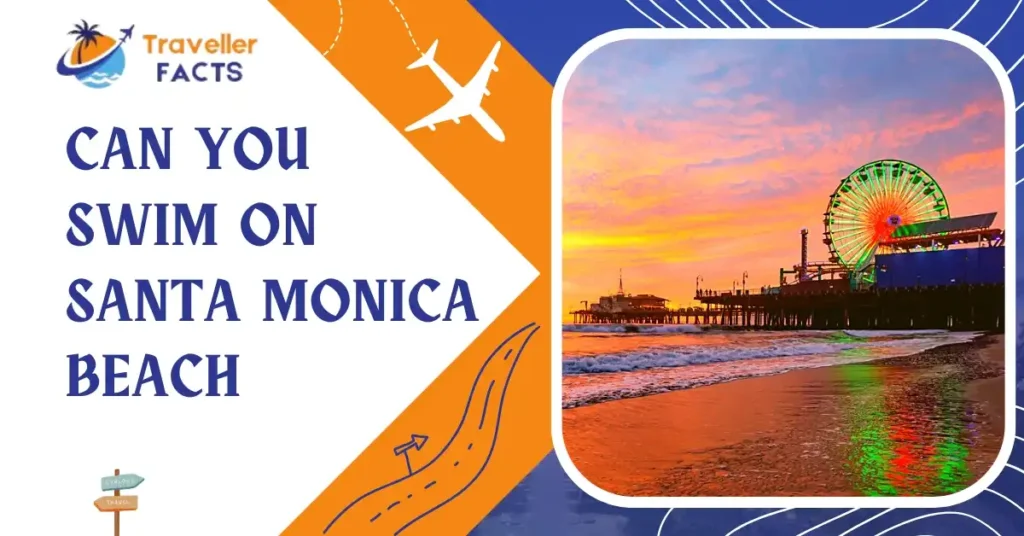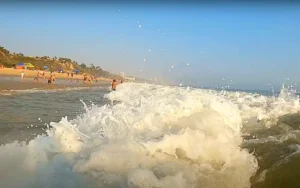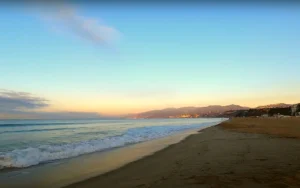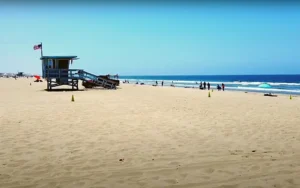Yes, you can swim at Santa Monica Beach. However, it’s important to be mindful of water quality, especially after rainstorms, and to heed any advisories posted by local authorities. The water quality at Santa Monica Beach is under constant surveillance by the Los Angeles County Department of Public Health. So, the water of this beach is quite clear to have a swim.
Before going swimming in Santa Monica Beach it is essential to ensure whether can you swim in Santa Monica Beach. So, read this article to know all about the Swimming details at Santa Monica beach.
Is It Possible to Swim on Santa Monica Beach?
Yes, you can swim at Santa Monica Beach without any tension. The water tends to be chilly, typically ranging from the low to mid-level.
However, it’s crucial to be aware that water quality can be inconsistent, and swimming advisories may be in place due to elevated bacteria levels.
The Los Angeles County Department of Health conducts regular water quality testing at various locations throughout the year.
However, try to refrain from swimming for a few days following rain, as precipitation can wash various chemicals into the ocean. Things to consider before going to Santa Monica Beach for Swimming:
Water Temperature
The Pacific Ocean, which bathes the shores of Santa Monica, is known for its chilly waters. So, firstly consider the water temperature at Santa Monica Beach.
Even during the summer months, water temperatures typically range from the low to mid-60 degrees Fahrenheit. While some may find this refreshing, it can be colder than what many swimmers are accustomed to.
Water Quality
Concerns about water quality have been raised in the past, especially around the Santa Monica Pier area.
However, it’s essential to note that Santa Monica Beach spans many miles along the coast. The water quality can vary within different sections of the beach.
The Heal the Bay organization provides regular updates and report cards on water quality. To assess the current water quality, travelers can consult the Heal the Bay report card, which is updated daily.
Weather Considerations
In general, swimming in Santa Monica Beach is more enjoyable during the summer months, such as July, when runoff from winter rains is less likely to affect water quality.
Runoff from rain can introduce pollutants into the ocean, impacting water quality. Travelers are encouraged to check for recent weather conditions and rainfall before their beach day to ensure safer swimming.
Bonus: If you are going to Santa Monica then you must know which things you can do in Santa Monica as couples.
Can You Swim near Santa Monica Pier?
Yes, you can swim near Santa Monica Pier. However, it is important to note that the water quality can vary.
The water quality near the Santa Monica Pier has occasionally garnered lower ratings. It’s essential to note that this doesn’t preclude swimming at Santa Monica Beach entirely.
Several sections of the beach consistently attain superior water quality ratings, and visitors have the option to choose these areas for their aquatic pursuits.
As an extra layer of safety, experts recommend avoiding swimming in close proximity to the pier.
The results of testing have indicated elevated levels of bacteria at the Santa Monica Pier. So, it necessitates caution among beachgoers to refrain from swimming, surfing, or engaging in ocean water activities.
However, if you are going to South Beach then you must know whether South Beach is topless or not.
Is Santa Monica Beach Clean Enough to Swim?
Water quality at Santa Monica Beach can fluctuate, and swimming advisories may be in place due to elevated bacteria levels.
Santa Monica Beach’s water quality is subject to regular monitoring by the Los Angeles County Department of Public Health. They collect weekly samples to test for bacteria levels.
While the beach generally provides a safe and inviting swimming environment, there are considerations to keep in mind.
Warning signs may be posted if water quality is compromised, particularly after rainfall that can wash contaminants into the ocean. To ensure a safe experience, it’s advisable to wait a few days after rain before swimming and to be aware of local advisories.
Swimming Near a Lifeguard Tower
Swimming near to a lifeguard tower at Santa Monica is not only a viable option but also a safe one.
Lifeguard Tower 20 and Tower 26, in particular, are favored locations for swimmers. Additionally, Santa Monica Pier hosts ocean swimming events, catering to both amateur and master swimmers.
However, it is crucial to be aware that the water quality can fluctuate, sometimes leading to advisories against swimming due to elevated bacteria levels. When water quality is compromised, the public may encounter warning signs at the beach.
Importance of Following Safety Measures When Swimming
Swimming in Santa Monica offers an enjoyable experience, but adhering to safety measures is of utmost importance for a secure beach outing.
It’s essential to remain aware of your surroundings, considering factors like strong currents, cold water, and weather, by checking the forecast.
Additionally, refraining from swimming shortly after rainstorms, avoiding storm drains, and steering clear of known polluted areas helps prevent health risks.
Staying within arm’s reach of young or untrained swimmers. Also avo iding alcohol consumption ensures quick responses and heightened awareness.
Consistently and correctly using safety equipment, such as life jackets and flotation devices, is pivotal for handling potentially perilous situations. These safety measures are vital for safeguarding yourself and your loved ones.
Is it safe to swim in Cape Cod? If you don’t have any idea about this then you must explore this.
Conclusion
Now you have an idea can you swim on Santa Monica beach or not?
Before taking a dip at Santa Monica Beach, it’s crucial to stay informed and aware. Knowledge about the current water conditions, potential hazards, and safety measures can enhance your beach experience and help ensure your safety.








